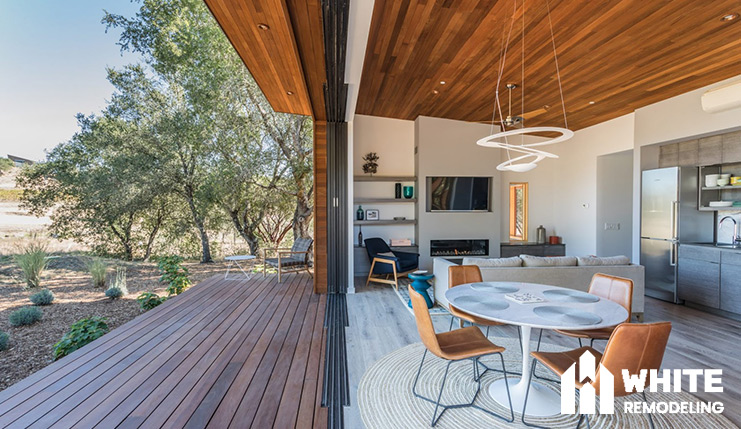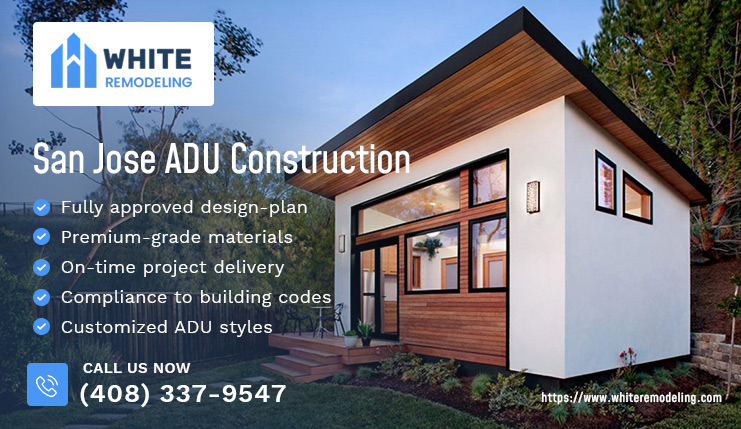Thanks to the positive state and local city of San Jose laws, more homeowners are now looking into adding detached structures to their properties for different purposes.
As your San Jose ADU construction expert, we have spent the last decade constructing several accessory units throughout San Jose and surrounding areas. We are here to help you with laws and walk you through permits and construction approvals.
From initial contact to final inspection, here’s our San Jose ADU construction process we follow:
To start off your San Jose ADU construction you must check in with your local zoning officials and if your plan to have the accessory structure is doable.
Starting with the Government Code Section 658525.2 and the JADU Zoning Ordinance, then visit the zoning office, we will guide you on these steps at our initial consultation. The zoning office will give more details on your requests based on your lot size and characteristics.


Based on the report from the zoning office, we will want to learn about your site location and local requirements for your zone, anchored on the city of San Jose ADU construction regulations. This often goes further into your preferred build size and specifications, along with your vision for the finishes on the unit.
This is where we start with practical analysis of your project, anchoring our guidance on the City’s ADU Universal Checklist and processing our findings into accurate details to help with design, permits and the eventual construction.
Our site inspection and feasibility study is meant to confirm what things you need to have in place given the local San Jose ADU construction requirements and your overall site settings. During this phase of the project we refer to your local mapping and assess your existing utilities to refine our assumptions about the site work.
Here is where we also modify your desired floor plan along with the right exterior elevations.
Before we go into designing your ADU construction in San Jose, you can count on us to guide you and make sure your lot is adequate in accord with the local development standards.
This refers to the size and number of additional dwelling units allowed on your property. We will make sure your proposed ADU conforms to the density constraints of your district.
In San Jose single-family properties are eligible for one detached ADU and one junior ADU. On the other hand, multifamily are eligible to add up to 25% of the existing units as attached ADUs.
As per San Jose ADU construction regulations, your ADU should be at least one-story and 16 ft. in height, and at most two-story and 24 ft. in height. This applies for detached ADUs on both single-family and multifamily properties, while attached ADUs’ height is limited to the main dwelling unit.
The regulations dictates that attached and detached ADUs should be built at least 4 ft. from your main dwelling unit’s side and rear lines, while junior and conversion ADUs need to set back a sufficient distance for fire safety.
This refers to the public utilities running under or over your property. We make sure your proposed ADU doesn’t limit access to these utilities.
Normally, junior and conversion ADUs don’t qualify for any parking. For attached and detached ADUs you should have will one parking spaces, except your project is exempted from parking requirements.
For instance, in San Jose single-family properties are eligible for one detached ADU and one junior ADU. On the other hand, Multi-family are eligible to add up to 25% of the existing units as attached ADUs.
Practically, with a lot size of 9,000 sq. ft. you can add a detached ADU of up to 1,000 sq. ft., while for lots larger than 9,000 sq. ft. you can add a detached ADU of up to 1,200 sq. ft. Also, Multifamily and duplex lots of any size can add both attached and detached ADUs of up to 800 sq. ft.
With our site inspection and feasibility report, we begin to design your project guided by your vision and local San Jose ADU construction regulations.
We start off by exploring different floor plans, then developing a site plan to help you understand how the accessory structure will sit on your property, and perhaps how the interior will be organized. We present different options to easily narrow in on your preferred choice.
Once you approve, we refine the floor plans and site plans on your feedback. We then set up a second appointment with you to go over the new 3D views of the project to define the overall look and feel.
The final talk will be on the elevations of each of the unit and sectional vertical relationships through spaces. All these coupled with functionality, style and flow.
Once you’re satisfied with the final design, we move forward documentation of the designs to get them ready for permitting and eventual construction.
We will proceed to schedule an appointment with the San Jose ADU Construction permit service and submit all the forms, plans and documents, which include:
We will schedule appointments with the permit officials for inspections, and eventual approvals.
With the relevant local San Jose ADU construction permits, construction work begins. We start by preparing the site which may need demolitions, clearing, or grading. We then proceed to foundations works, framing the structures, system installations, and interior finishing.
As per the local San Jose ADU construction guidelines and guided with Inspection Checklist for ADUs, we will also schedule appointments at the right stages for inspections – foundation works, framing, roofing, plumbing, and electrical layout.
Once the construction is complete we will completed the Construction & Demolition Diversion (CDD) review and set up a final inspection, so you can move in.


Over the years, ADUs have gained huge traction among policymakers interested in increasing the supply of affordable housing through the densification of existing built spaces.
An evolving considerations of best practices in regulations and financing have helped support early stage adoption, and we agree that the time is right to bring ADUs to scale in your areas by guiding you through these potential state grants and financial incentives:
This set of questions & answers created by our experts can help get a better understanding of our ADU garage conversion services & processes.
Not just in San Jose, but across California, all homeowners must follow a setback of 4’ (feet) from the rear and side while designing an ADU. A detached ADU must be 10’ (feet) away from the main residence and 5’ away from any property lines.
It usually takes anywhere between 60-120 days to get the design-plan approved and the local permits issued from the municipality and the building & safety department. It depends how flawlessly the ADU master-plan has been designed.
Under the California state law, the maximum size limit for an attached ADU is 1200 sq. ft. or limited to half the size of the existing residence, whichever is smaller. Detached ADUs can be bigger in size.
Uncover essential details about San Jose’s Accessory Dwelling Unit (ADU) […]
A garage conversion can be an excellent way to maximize […]
Learn how you can use your garage area after you […]
An insight into some important points to note as you […]